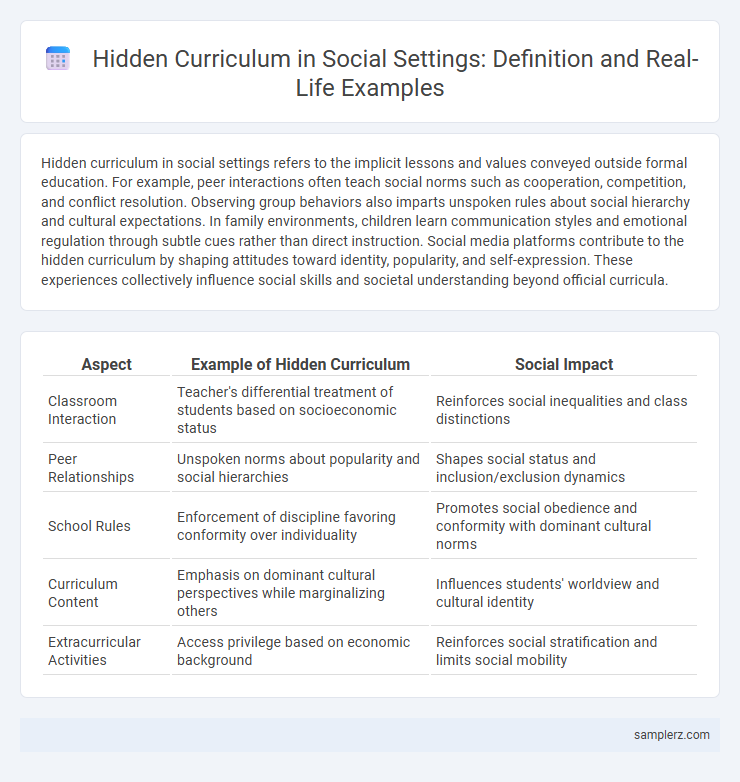Hidden curriculum in social settings refers to the implicit lessons and values conveyed outside formal education. For example, peer interactions often teach social norms such as cooperation, competition, and conflict resolution. Observing group behaviors also imparts unspoken rules about social hierarchy and cultural expectations. In family environments, children learn communication styles and emotional regulation through subtle cues rather than direct instruction. Social media platforms contribute to the hidden curriculum by shaping attitudes toward identity, popularity, and self-expression. These experiences collectively influence social skills and societal understanding beyond official curricula.
Table of Comparison
| Aspect | Example of Hidden Curriculum | Social Impact |
|---|---|---|
| Classroom Interaction | Teacher's differential treatment of students based on socioeconomic status | Reinforces social inequalities and class distinctions |
| Peer Relationships | Unspoken norms about popularity and social hierarchies | Shapes social status and inclusion/exclusion dynamics |
| School Rules | Enforcement of discipline favoring conformity over individuality | Promotes social obedience and conformity with dominant cultural norms |
| Curriculum Content | Emphasis on dominant cultural perspectives while marginalizing others | Influences students' worldview and cultural identity |
| Extracurricular Activities | Access privilege based on economic background | Reinforces social stratification and limits social mobility |
Unspoken Social Norms in Schools
Hidden curriculum in schools includes unspoken social norms such as the expectation to respect authority, the implicit rules of classroom behavior, and the subtle reinforcement of gender roles through group activities. These norms shape students' social interactions, influencing their communication styles and peer relationships. Understanding these hidden lessons reveals how schools contribute to socialization beyond formal education.
Implicit Gender Roles Among Peers
Implicit gender roles among peers manifest through subtle social interactions that reinforce traditional expectations, such as boys being encouraged to engage in competitive play while girls are steered towards cooperative activities. These unwritten rules are internalized by children, shaping their social behaviors and self-perceptions without explicit teaching. Peer acceptance and social status often depend on conforming to these gendered norms, perpetuating stereotypes within group dynamics.
The Influence of Dress Codes on Social Behavior
Dress codes subtly enforce social norms by shaping individuals' behavior and perceptions without explicit instruction, promoting conformity and discipline in educational and professional settings. These regulations influence social interactions by creating implicit hierarchies and expectations about appearance, which affect status, inclusion, and group identity. By dictating acceptable attire, dress codes reinforce cultural values and social boundaries, often reflecting broader societal attitudes toward gender, class, and professionalism.
Social Hierarchies and Group Dynamics
Hidden curriculum in social contexts often manifests through subtle reinforcement of social hierarchies and group dynamics, where individuals learn status recognition and power relations without explicit instruction. For example, students observe seating arrangements in classrooms that reflect unwritten social orders or experience peer interactions that signal inclusion and exclusion based on group membership. These implicit lessons shape understanding of social roles and influence behavior within various communities and institutions.
Inclusion and Exclusion within Friendships
Hidden curriculum in social settings manifests through subtle lessons about inclusion and exclusion within friendships, where children learn unspoken rules about who belongs to certain groups based on factors like socioeconomic status, ethnicity, or interests. These implicit social cues reinforce power dynamics and social hierarchies, shaping children's understanding of acceptance and rejection. Observing who is invited to social events or excluded from conversations reveals the hidden curriculum's impact on developing social identity and peer relationships.
Unwritten Rules of Classroom Participation
Unwritten rules of classroom participation include norms such as raising hands to speak, respecting peers during discussions, and following teacher cues without explicit instruction. These social expectations shape student behavior and influence learning engagement, often benefiting those familiar with these conventions. Understanding these hidden curriculum elements is crucial for fostering inclusive and equitable educational environments.
Attitudes Toward Authority Figures
Hidden curriculum in social settings often manifests through attitudes toward authority figures, subtly teaching obedience and respect as unspoken social rules. For instance, students learn to accept hierarchical structures by observing teachers' control and societal deference to police or government officials. This implicit instruction shapes social behavior by reinforcing power dynamics without explicit discussion.
Peer Pressure and Conformity
Hidden curriculum in social contexts often manifests through peer pressure, where individuals learn to conform to group norms without explicit instruction. This implicit social learning influences behaviors, attitudes, and values, reinforcing conformity to maintain group cohesion. Peer pressure subtly teaches the importance of acceptance, obedience, and social approval, shaping social identity and group dynamics.
Understanding Respect and Politeness in Social Contexts
Understanding respect and politeness in social contexts often involves hidden curriculum elements such as unspoken rules for addressing others, interpreting body language, and managing conversational turn-taking. These implicit lessons teach individuals how to navigate social hierarchies and cultural norms, fostering positive interpersonal interactions. Mastery of these subtle social cues contributes significantly to effective communication and relationship-building.
Cultural Biases Conveyed Through Everyday Interactions
Hidden curriculum in social settings often manifests through cultural biases conveyed in everyday interactions, such as language use, body language, and social norms that implicitly favor dominant groups. For instance, greeting customs and conversational turns may privilege certain cultural backgrounds, reinforcing stereotypes and social hierarchies without explicit instruction. These subtle signals shape individuals' perceptions and behaviors, perpetuating inequality and exclusion within diverse communities.

example of hidden curriculum in social Infographic
 samplerz.com
samplerz.com